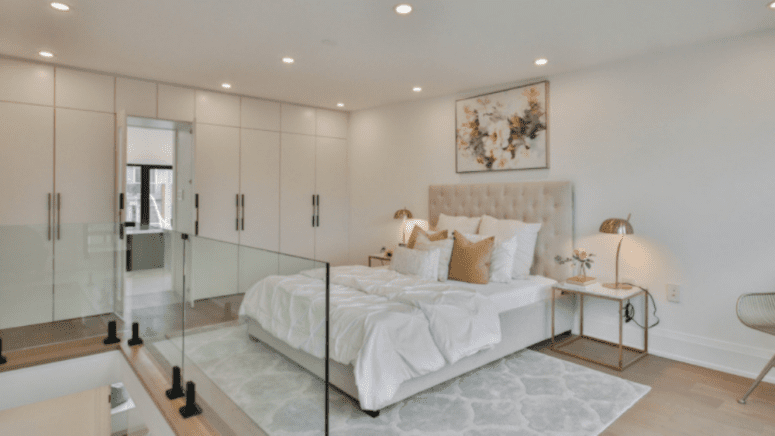Unpermitted Additions: Here’s What You Need to Know Before Buying a Home with DIY Renovations
- Published on
- 13 min read
-
 Courtney DuChene, Contributing AuthorClose
Courtney DuChene, Contributing AuthorClose Courtney DuChene Contributing Author
Courtney DuChene Contributing AuthorCourtney DuChene is a freelance writer covering business, personal finance and real estate, based out of Philadelphia.
-
 Jedda Fernandez, Associate EditorClose
Jedda Fernandez, Associate EditorClose Jedda Fernandez Associate Editor
Jedda Fernandez Associate EditorJedda Fernandez is an associate editor for HomeLight's Resource Centers with more than five years of editorial experience in the real estate industry.
Imagine you’ve found your dream home — it has the perfect amount of space for your family, large windows that let in morning light, and a backyard patio with plenty of space for entertaining on warm summer evenings.
But, when your inspector goes through the home, they notice that the siding in the back is a slightly different shade than the rest of the house. They check the property records with the city and tell you that they suspect one of the rooms is an unpermitted addition.
What should I do now? Is it safe to buy a home with unpermitted work?
Unpermitted additions are a fairly common, and slightly alarming, hiccup when it comes to buying a home. If you’ve encountered one in your home search, you might be wondering what your next steps should be. We’ve talked to an expert real estate agent and home inspectors to better understand what an unpermitted addition is and what it means for homebuyers. Let’s dive in.
What is an unpermitted addition?
Unpermitted additions include any form of remodel or renovation on a home where the owners did not obtain the proper permits from the city’s building department, even though a permit was required to begin work.
Little projects like painting or updating flooring don’t require permits, but most larger-scale projects do.
A wide range of home features could be considered unpermitted additions. Large-scale remodels, like adding a bathroom or another bedroom, are examples of projects that could be unpermitted additions if the owners completed this work without obtaining permits. As a general rule, any project that makes a change to the electrical and plumbing systems or the structure of the home needs a permit.
However, smaller projects like replacing gutters or adding a fence could also be considered unpermitted additions if your area’s zoning or building boards require owners to acquire a permit before beginning construction.
“It can be as little a thing as someone building a barbecue area in the backyard, to a full room addition,” says Edward Kaminsky, a top real estate agent who sells 66% more single family homes than the average agent in Manhattan Beach, California.
“I have seen numerous unpermitted additions,” added Mike Powell, P.E., CPI, a home inspector and structural engineer with the Tampa Bay-based Red Flag Home Inspection, LLC.
In some areas, unpermitted work is a bigger deal than in others. Homes built in earthquake zones, or in areas where hurricanes are common, likely have to conform to higher local building code standards to ensure that they can withstand natural disasters.
“The topic of unpermitted construction plays a pretty heavy role here in Florida, due to our wind-code requirements,” Powell says. “Building codes are minimum standards that ensure public health and safety. In construction, they also uphold the integrity of the installation and ensure items will hold up to the regional environment.”
Why would a home have unpermitted work?
Usually, homeowners think about the additions they make to their home as adding value, and therefore don’t think through the consequences of carrying out unpermitted work. If the seller is a confident DIY-er or a contractor, they may forgo pulling permits before updating a bathroom or putting up a fence.
“Some homeowners think that they’re going to keep their home forever and therefore doing work without a permit doesn’t seem like a big issue, but problems can arise for them later when they eventually decide to sell,” says home inspector Danny Smith, CEO of Semper Fi Home Inspections.
In other cases, a homeowner might not have known that they needed a permit to complete the work. What seems like a simple DIY project that could be completed in a weekend may require a permit in some municipalities.
Take window replacements as an example — it may seem like an easy project, but area zoning and building codes may consider it a structural change, especially if you plan on replacing more than one.
Common unpermitted additions
Anything from adding a deck or patio space to increasing the number of bedrooms or bathrooms in a home could be an unpermitted addition. Let’s take a look at some of the most common ones.
- Finishing a basement
- Finishing or converting a garage
- Adding a bedroom or home office
- Adding additional bathrooms
- Turning a partially-screened porch into a sunroom
- Some window replacements
Risks of buying a home with unpermitted additions
Buying a home with unpermitted additions can come with a number of risks. Kaminsky advises buyers to carefully think through whether they feel comfortable purchasing a home with unpermitted additions.
Before you jump in and make an offer, it’s important to consider the following scenarios:
You might have to tear the structure down
Having to tear down the addition and build a new, up-to-code replacement is by far the biggest risk buyers face when buying a house with unpermitted additions. Buyers can often apply for a permit for the addition after it’s completed. However, if the city inspects the new room and finds it’s not up to code, they will likely ask the buyer to tear it down.
“Worst case scenario, the city says no on the permit and you must have it removed,” Kaminsky says.
Tearing down and rebuilding a new addition can come with a hefty price tag. Though costs will vary based on the scope of the project, rebuilding a whole room can cost as much as $21,946 to $83,320.
Mortgage troubles
In some cases, mortgage companies will agree to finance a home with unpermitted additions so long as there’s a plan to bring the home up to code either before or after closing, according to Smith. But if the addition was so poorly constructed that it’s a safety hazard, or if it can’t be easily fixed, then your lender may refuse to finance the purchase.
Don’t think about trying to hide the unpermitted addition from your lender, either. If you knowingly purchase a home with unpermitted work and hide it from them, they could “call” your loan or demand payment in full. These situations are rare, but they’re not worth the risk in any scenario.
Appraisal issues
Appraisers will not count unpermitted additions as part of a home’s square footage, which can cause the appraisal to come in low. For instance, if one of the rooms in a four-bedroom home is unpermitted, your appraiser might only view it as a three-bedroom home and might not give that extra room any value.
Consequently, they’ll look at what comparable three — rather than four — bedroom homes in your area have sold for. That can create problems if the appraisal comes in lower than the purchase price and your lender will not lend you what you need to purchase the home.
Insurance may not cover unpermitted work
Let’s say an unpermitted addition involved electrical work — the previous homeowners completed it themselves, and it wasn’t quite up to code. Years later, after you’ve purchased the home, the wiring causes a fire, and your homeowner’s insurance policy might not cover the damages.
“Many times, a permit isn’t obtained when a homeowner is doing the work themselves. This can be a huge risk if they were undertaking updates involving structure, electricity, and plumbing — unless they are well experienced and licensed in such things. These activities can be a safety risk; bad wiring could cause a fire, for example,” Smith says.
How to tell if a home has an unpermitted addition
Check the disclosures
The simplest place to check for unpermitted work is in the seller’s disclosures. If the seller knows their home has unpermitted work or if they completed the work themselves, they are required to disclose it.
If they fail to disclose, you could be able to sue them for misleading real estate practices if your attorney can prove that they knew about the unpermitted addition and deliberately kept it out of the disclosures.
Ask to see the blueprints
If you’re on a tour and notice something that could indicate unpermitted work — say, if you notice a slightly different shade of brick or siding on one part of the exterior of the home — you can ask your buyer’s agent if it’s possible for the seller to share the original blueprints for the home.
That way, you can see if the room was included in the original plans or if the home’s layout matches the original design. If it doesn’t, that could be a sign unpermitted work was done on the house.
Ask the seller directly
If you suspect that the home has unpermitted work, your buyer’s agent can always step in and ask the listing agent when a particular addition was added to a home and whether or not the sellers pulled the proper permits.
Check if previous owners pulled permits
Most cities have databases where you can look up whether a contractor pulled permits for a particular project. These databases are usually found on the website for your city or local government’s licenses and inspections department.
Just type in the address of the house you want to look up, and it should show you whether any permits have been pulled for that property. If your city doesn’t have a portal, you can call the department and ask if there are any open permits on the property or if any closed permits were filed.
Ask your home inspector
Home inspectors are often able to tell when a home has unpermitted work or when completed work isn’t up to code.
“Basically as home inspectors, we inspect for any repairs as well as additions that were not done in a professional manner or are not performing their intended purpose,” Smith says.
Smith shares that the best place to look for unpermitted additions is the attic: “It is easier to see where the structure has been modified with the rafters and roof line, sometimes with the original roof still visible and the new higher roof tied in above it,” he says.
Ask your appraiser
Your appraiser is another resource who can help you determine whether a home has unpermitted additions. They may look up the property records for a home and notice that a particular addition isn’t included. That would mean the addition is likely unpermitted.
What can I do if I discover an unpermitted addition?
If you discover unpermitted work before you put in an offer on a home, then it’s easy to just walk away and never have to worry about the issue again. That’s why it’s important to check city databases and be on the lookout for signs of unpermitted additions on your home tours.
But if you discover the unpermitted work after putting in an offer, don’t panic. There’s still some steps you can take to protect yourself and your pocket book.
Here are some options you have as a buyer if you discover unpermitted work after getting an offer accepted on a home:
Head back to the negotiation table
If you discover a home has unpermitted additions, you should always ask the seller to cover the costs of retroactively obtaining a permit or bringing the addition up to code. If they don’t want to pay for the permits themselves, you can try to negotiate a reduction in sale price to cover the cost of retroactively obtaining the permits and doing repairs yourself.
Walk away from the sale
If you discover the unpermitted additions during the inspection process, and you have an inspection contingency, you can always walk away from the sale. An inspection contingency allows buyers to back out of a sale if the inspection uncovers anything they’re not comfortable with.
Should I buy a home with an unpermitted addition?
If you find out a home you were planning to make an offer on has an unpermitted addition, it’s best to exercise caution. You should ask questions about the extent of the work that was completed and whether it can be easily brought up to code.
Kaminsky recommends talking to the seller and seeing if they’d be willing to have a city official inspect the addition and draft a report detailing what would need to be done to bring the structure up to code before making an offer. He notes that some sellers may be unwilling to do that, however, because it would then alert the city to the unpermitted work.
“A seller may not want you to do that and call it out, especially if you’re not committed to purchasing the home,” Kaminsky says.
And, of course, there are some cases where unpermitted work is never acceptable. Both Powell and Smith advise against buying homes where the seller transformed a sloping patio into an additional room, as they can often have major foundational or structural issues down the line.
“The patio slab wasn’t intended to be thick enough to support the extra weight of a structure above it, usually showing up in foundation issues in that area with cracks in the walls and gaps between the room addition and the main structure,” Smith says.
Kaminsky agrees that homeowners need to be wary of structural issues if they’re considering buying a home with unpermitted additions. “To me, the most concerning would be if something wasn’t structurally correct because that’s usually the most expensive thing to fix and certainly has the most risk of causing future tragedies for that matter,” Kaminsky says.
A top buyer’s agent can help advise you on what to do if you encounter an unpermitted addition in your home search. They can help explain how common unpermitted additions are in your particular area and the risks they may pose.
Header Image Source: (Sidekix Media / Unsplash)
Editor’s note: This article is for educational purposes only and is not intended as financial or legal advice. HomeLight always encourages you to reach out to an advisor regarding your own situation.
- "When Homeowners Must Obtain Permits for Home Projects", NOLO (July 2023)
- "Selling & Buying A House With Unpermitted Construction", CCS Inc (September 2024)
- "How Much Does a Home Addition Cost in 2024?", HomeAdvisor (September 2024)
- "Do I Need to Obtain Permits to Install Replacement Windows?", R&M Quality Windows & Doors (October 2024)




